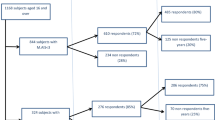Abstract
Sixty-six passengers surviving a collision of two trains were investigated concerning relevant background data, degree of personal injury, experience of a threat to life, symptoms and problems immediately after the accident, and thoughts about difficulty in coping. The most obvious impact on the survivors was the experience of being close to death. One result of this was that they developed a new coping strategy to minimize emotional pain. Some survivors also suffered problems of “re-living” the accident. This is important for the coping process. The process includes psychological integration of the accident as an important life event. The findings indicate that “re-living” of the accident through nightmares and intrusive thoughts is responsible for problems in carrying out ordinary tasks. The observations are in accordance with those made after other types of accidents and disasters.
Similar content being viewed by others
References
American Psychiatric Association. (1987).Diagnostic and statistical manual of mental disorders (3rd ed. rev.). Washington D.C.: Author.
Arozenius, S. (1977). Psykiska besvär efter tågkatastrofen i Mjölby påsken 1975 [Psychological symptoms after the train accident in Mjölby, Easter 1975].Nordisk Psykiatrisk Tidskrift, 31, 471–483.
Boman, B. (1979). Behavioural observations on the Granville Train Disaster and the significance of stress for psychiatry.Social Science and Medicine, 13A, 463–471.
Bowlby, J. (1973).Separation: Anxiety and anger. London: Hogarth Press.
Bowlby, J. (1980).Loss: Sadness and depression. London: Hogarth Press.
Brown, J.T. (1979). Grief response in trauma patients and their families.Advances in Psychosomatic Medicine, 16, 93–114.
Campbell, M.J., & Gardner, M.J. (1988). Calculating with confidence intervals for some non-parametric analyses.British Medical Journal, 296, 1454–1456.
Caplan, G. (1964).Principles of preventive psychiatry. New York: Basic Books.
Ersland, S., Weisaeth, L., & Sund, B. (1980). The stress upon rescuers involved in an oil rig disaster, “Alexander L. Kielland” 1980.Acta Psychiatrica Scandinavica (Suppl. 355),80, 38–49.
Gardner, M.J., & Altman, D.G. (1988). Estimating with confidence.British Medical Journal, 296, 1210–1211.
Holen, A. (1990).A long term outcome study of survivors from a disaster. The Alexander L. Kielland disaster in perspective. Monograph, University of Oslo.
Holen, A. (1991). A longitudinal study of the occurrence and persistence of post-traumatic health problems in disaster survivors.Stress Medicine, 7, 11–17.
Horowitz, M.J. (1978).Stress response syndromes. London: Aronson.
Langman, M.J.S. (1986). Towards estimation and confidence intervals.British Medical Journal, 292, 716.
Lazarus, R. (1966).Psychological stress and the coping process. New York: McGraw Hill.
Lindström, B., & Lundin, T. (1982). Yrkesmässig exposition för katastrof [Professional exposure to disasters].Norsiak Psykiatrisk Tidsskrift (Suppl. 6),36.
Lundin, T. (1982).Mourning and grief: A study on reactions following sudden and unexpected deaths (in Swedish—summary in English). Monograph, Uppsala University.
Morris, A.J., & Gardner, M.J. (1988). Calculating confidence intervals for relative risks (odds ratios) and standardized ratios and rates.British Medical Journal, 296, 1313–1316.
Raphael, B. (1977). The Granville Train Disaster. Psychological needs and their management.Medical Journal of Australia, I, 303–305.
Raphael, B. (1979–80). A primary prevention action programme: Psychiatry involvement following a major rail disaster.Omega, 10(3), 211–226.
Raphael, B., Lundin, T., & Weisaeth, L. (1989). A research method for the study of psychological and psychiatric aspects of disaster.Acta Psychiatrica Scandinavica (Suppl. 353),80, 1–75.
Raphael, B., Singh, B., Bradbury, L., & Lambert, F. (1983–83). Who helps the helpers?Omega, 14, 9–20.
Singh, B., & Raphael, B. (1981). Postdisaster morbidity of the bereaved.Journal of Nervous and Mental Disease, 169(4), 203–212.
Weisaeth, L. (1984).Stress reactions to an industrial disaster. Monograph, University of Oslo.
Weisaeth, L. (1989a). The stressors and post-traumatic stress syndrome after an industrial disaster.Acta Psychiatrica Scandinavica, 80 (Suppl. 355), 25–37.
Weisaeth, L. (1989b). Importance of high response rates in traumatic stress research.Acta Psychiatrica Scandinavica, 80 (Suppl. 355), 131–137.
Author information
Authors and Affiliations
About this article
Cite this article
Hagström, R. The acute psychological impact on survivors following a train accident. J Trauma Stress 8, 391–402 (1995). https://doi.org/10.1007/BF02102965
Issue Date:
DOI: https://doi.org/10.1007/BF02102965




